Perfume Pagoda is one of Vietnam’s national scenic spots, attracting the most visitors in Hanoi. The allure of the Perfume Pagoda tourist area not only lies in its renowned spiritual significance but also in its breathtaking beauty, reminiscent of a fairyland. If you’re planning a trip to explore Perfume Pagoda, be sure to check out VnCarRentals.com’s detailed travel guide below for the best experience!
Table of Contents
Introduction to Perfume Pagoda
Perfume Pagoda is an excellent destination for both worshiping Buddha and enjoying the stunning natural scenery.
Where is Perfume Pagoda?
Perfume Pagoda (Huong Pagoda) is the short name for a complex of many pagodas located on the Huong Son Mountain in My Duc district, Hanoi. This place was visited by President Ho Chi Minh, who instructed, “Perfume Pagoda is a beautiful site. We must cherish and preserve it for future generations to enjoy and love their homeland and country even more.”
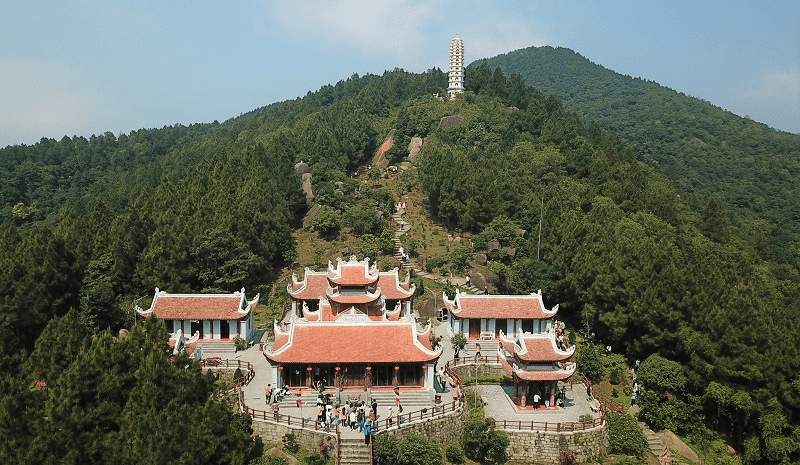
Throughout the ups and downs of history, Perfume Pagoda has become one of the cultural and religious centers of Vietnam, with many sacred temples and pagodas like Huong Tich Cave, Thien Tru Pagoda, Trinh Temple, and Giai Oan Pagoda.
Perfume Pagoda is located on the right bank of the Day River, in Huong Son commune, My Duc district, about 62 km southwest of central Hanoi. It only takes about an hour by car to reach this famous tourist site.
History of Perfume Pagoda
Perfume Pagoda dates back to the 15th century and was mainly built in the late 17th century. However, it was destroyed during the resistance against French colonization. In 1989, Perfume Pagoda was restored by Venerable Thich Vien Thanh under the guidance of the late Venerable Thich Thanh Chan. The reconstruction of Thien Tru Pagoda began and was completed in 1991. In the following years, structures such as the Nam Thien Mon Gate and others were built, resulting in the magnificent architectural complex we see today.
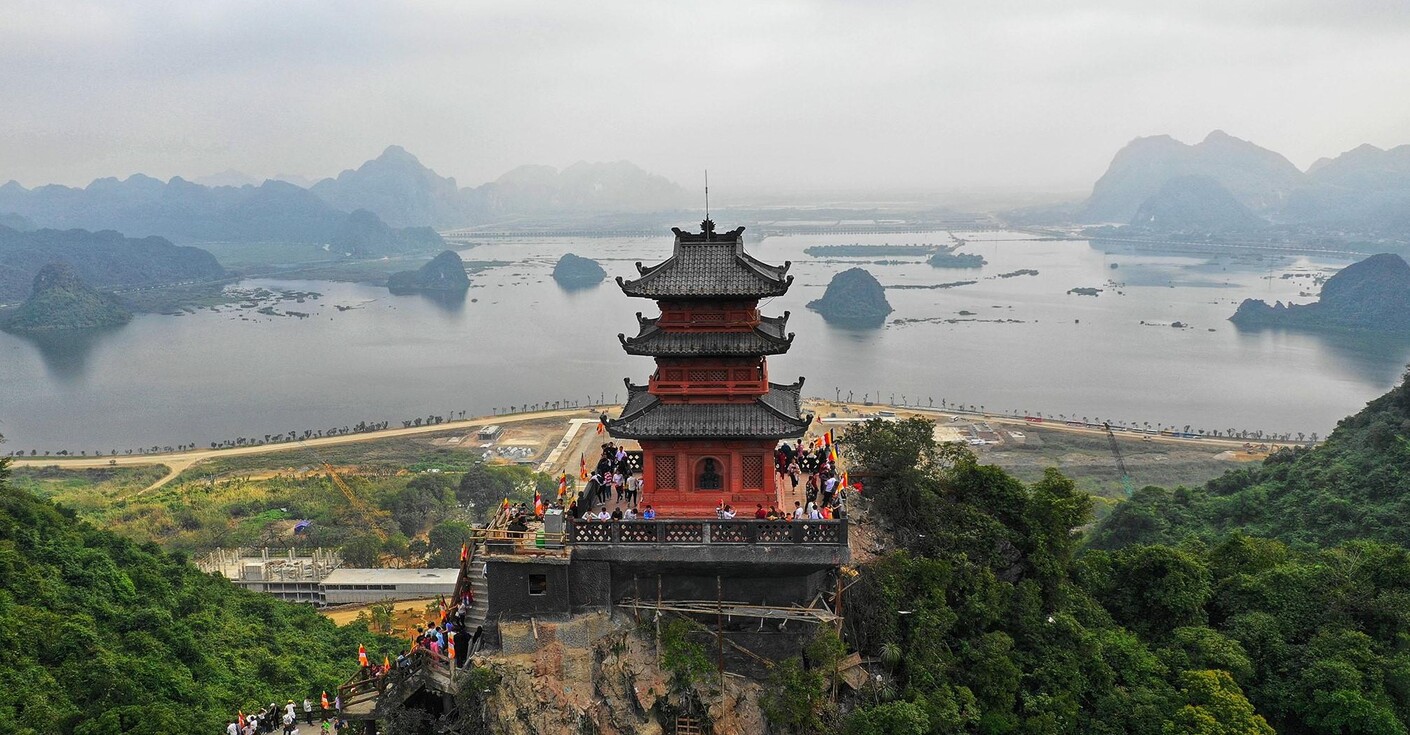
Many may not know exactly whom Perfume Pagoda is dedicated to. As a complex of many temples, it accommodates various beliefs.
- Trinh Temple is located on the Ngu Nhac Mountain range, resembling a giant dragon. An ancient temple dedicated to General Quan Tu Ma Hung Lang, who helped King Hung VI defeat invaders, was erected here.
- Huong Tich Cave is where Princess Dieu Thien, an incarnation of Avalokitesvara Bodhisattva, attained enlightenment and became a Buddha. Visitors here can admire the green stone statue of Avalokitesvara carved during the Tay Son Dynasty in 1793.
- Cua Vong Temple worships the “Lady of the Forest,” Thuong Ngan Van Huong Princess Le Mai Thanh Mau.
- Thien Tru Pagoda, also known as Chua Ngoai (Outer Pagoda), is a large monastery where Buddhist monks study and store Buddhist scriptures, laws, and doctrines.
In addition, the Perfume Pagoda complex features other unique structures like Dai Bac Pagoda, Quan Temple, Giai Oan Pagoda, and various beautiful caves dedicated to local beliefs.
Architecture of Perfume Pagoda
Perfume Pagoda is a Vietnamese cultural and religious complex with dozens of temples, shrines, communal houses, and caves spread across the Yen Stream valley. Each temple in the Huong Tich area has its distinct architecture, and the complex is divided into four main areas:
- Huong – Thien Area includes 8 monuments: Huong Tich Cave, Thien Tru Pagoda, Trinh Temple, Giai Oan Pagoda, Cua Vong Temple, Tien Son Pagoda, Hinh Bong Pagoda, and Dai Binh Cave.
- Thanh Huong Area includes 2 monuments: Thanh Huong Pagoda and Huong Dai Cave.
- Long Van Area includes 4 monuments: Long Van Pagoda, Long Van Cave, Cay Khe Cave, and Thanh Hoa Cave.
- Tuyet Son Area includes 4 monuments: Bao Dai Pagoda, Ngoc Long Cave, Ngu Tri Pagoda (Fish Pagoda), and Trinh Phu Yen Temple.
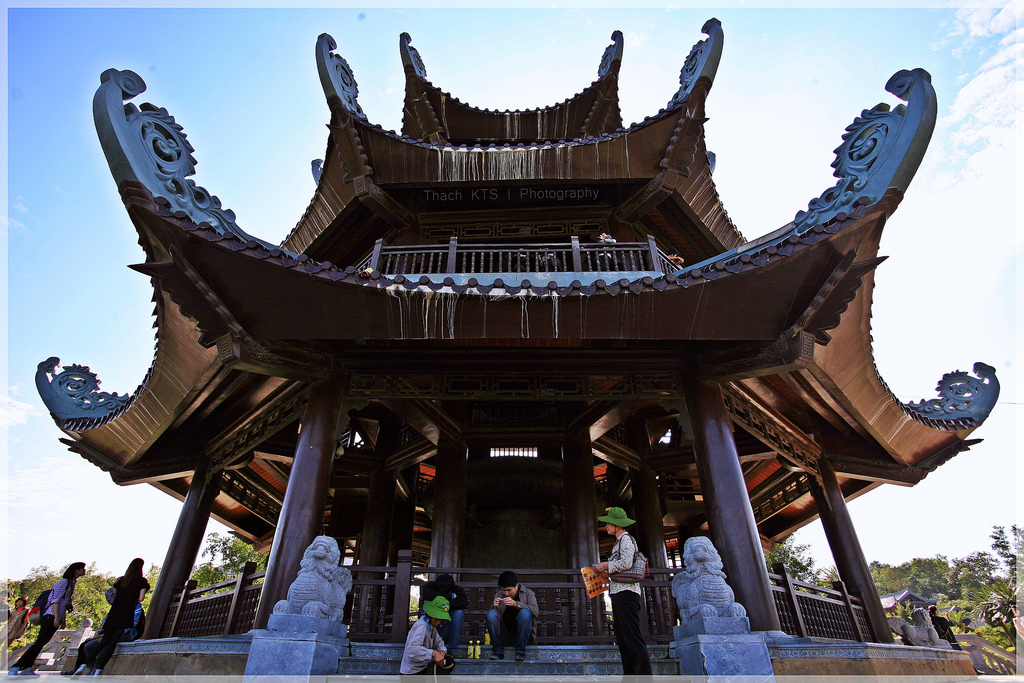
Perfume Pagoda’s architecture is mainly built into the mountains and caves, which gives it a unique appeal. Thien Tru Pagoda was once compared to a magnificent castle, but it was destroyed during wars. Today, only the Tower Garden remains, including the Vien Cong Tower, a terracotta artwork from the 17th century, and the Thien Thuy Tower. Huong Tich Cave, or the Inner Pagoda, which honors Avalokitesvara, is a natural cave with a large gate engraved with the characters “Hương Tích động môn” (Entrance to Huong Tich Cave). To reach the cave, visitors must descend a stone-paved path with 120 steps, with inscriptions on the cave wall reading “The First Cave under Heaven.”
Perfume Pagoda Travel Experience
Perfume Pagoda is not only famous for its beauty, resembling a heavenly landscape, but also for the spiritual festivals, cultural activities, and local cuisine you can explore in this sacred land.
Best Time to Visit Perfume Pagoda
Due to its picturesque location surrounded by mountains and rivers, Perfume Pagoda is beautiful to visit year-round. However, it is most famous for its festival, which lasts from the first to the third lunar month, when thousands of visitors flock here to attend the festival and sightsee. This is the peak season for Perfume Pagoda, so if you want to experience the festive atmosphere, this is the best time to visit!
The main festival at Perfume Pagoda begins on the 6th day of the first lunar month and lasts until the 18th of the second lunar month. It is the largest festival in northern Vietnam, bringing together the country’s three major religions. It attracts millions of pilgrims and tourists on a spiritual journey to the Buddha’s land.
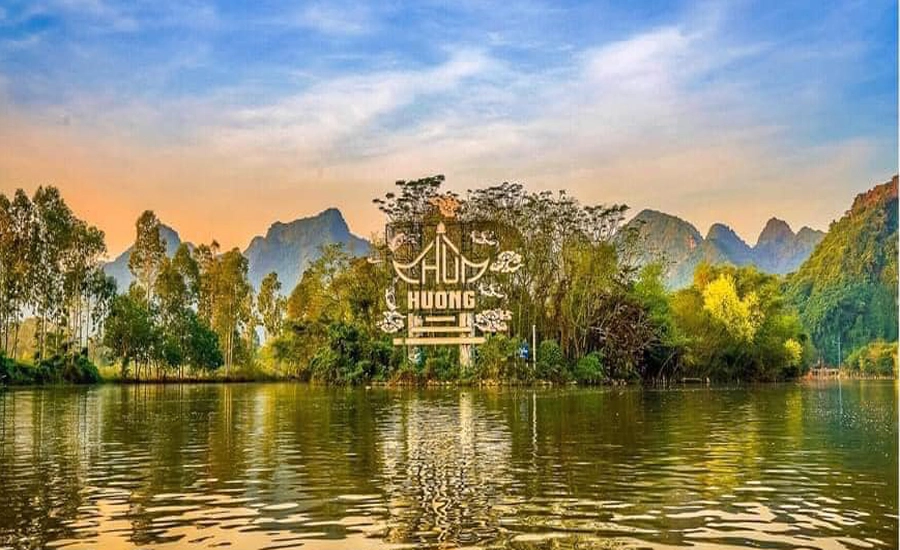
Aside from the pilgrimage and prayers for a prosperous new year, visitors can also enjoy many traditional activities such as boat rowing, traditional singing performances like “hat cheo” and “hat chau van.”
If you visit during the third lunar month, you will be greeted by the vibrant red blossoms of the bombax trees lining both sides of the Yen Stream. Floating down the stream while enjoying the beautiful and romantic scenery is a wonderful experience. Be sure to capture some stunning photos in this charming setting!
Additionally, Perfume Pagoda is also breathtaking during the water lily season from September to November along the Yen Stream. The peaceful and poetic landscape, accentuated by the wild beauty of the pink and purple water lilies and the floating melaleuca flowers, creates a mesmerizing watercolor painting.
How Much Does It Cost to Visit Perfume Pagoda?
Located relatively close to Hanoi, visiting Perfume Pagoda is not expensive. The main expenses are entrance tickets, boat rides, cable car tickets, and food in the tourist area.
The cost of a trip to Perfume Pagoda depends on your preferences, but the main expenses are as follows:
- Entrance fee to the entire Perfume Pagoda complex: 80,000 VND per person, allowing access to all 21 sites within the area.
- Boat ride:
- Main route to Huong Tich: 50,000 VND per person for a round-trip.
- Routes to Tuyet Son and Long Van: 35,000 VND per person for a round-trip.
- Cable car tickets:
- Adults: 120,000 VND for a one-way trip, 180,000 VND for a round-trip.
- Children: 90,000 VND for a one-way trip, 120,000 VND for a round-trip.
Children under 1.1 meters and under 10 years of age receive free entry. Additionally, entrance fees are waived on specific days, such as Heritage Day (November 23), Tet holidays (December 30 to January 2), and Buddha’s Birthday (April 15).
Traveling to Perfume Pagoda from Hanoi
Perfume Pagoda is about 62 kilometers from Hanoi, making it easy to visit in a day by various means of transportation, such as motorbike, car, bus, or private tour vehicles.
For those from other provinces who wish to visit Perfume Pagoda, you can travel to Hanoi first and then head to the pagoda. Here are some travel tips for visiting Perfume Pagoda from Hanoi:
- By Motorbike: This is a popular choice due to its convenience and flexibility, particularly for young travelers. However, if you’re traveling in a large group, it’s better to consider other transportation options. The route from Hanoi follows Nguyen Trai – Thanh Xuan – Ha Dong – Ba La – National Highway 21B. The trip covers about 59 km and takes approximately 1.5 hours.
- By Private Car Rental: If you’re traveling with family or in a large group, you can opt to rent a private car from Hanoi through VnCarRentals.com. This option provides convenience with door-to-door pick-up services and experienced drivers, ensuring a safe and comfortable journey.
- By Bus: This is a budget-friendly and convenient option for a one-day trip to Perfume Pagoda. Below are some bus routes:
- Route 103: My Dinh – Huong Pagoda (9,000 VND per person). The route includes stops such as My Dinh Bus Station – Pham Hung – Khuat Duy Tien – To Huu – Mo Lao – Nguyen Van Loc – Nguyen Trai – Tran Phu (Ha Dong) – Phung Hung (Ha Dong) – Phuc La Road, Van Phu – Nam Ha Tay Province Road (Cienco 5) – Provincial Road 427B – National Highway 21B – Provincial Road 424 (DT 76) – Provincial Road 419 – Huong Son (Duc Khe Bus Station, Huong Son Commune, My Duc District).
- Route 75: Yen Nghia – Huong Son (25,000 VND per person). The route includes stops such as Yen Nghia – Ba La – Chuong – Vac – Van Dinh – Hoa Nam – Dang Giang – Doc Bo – Huong Son Bus Station.
- Route 215: Giap Bat – Huong Son (12,000 VND per person). The route includes stops such as Giap Bat Bus Station – Giai Phong – Nguyen Huu Tho – Linh Dam Urban Area – Cau To – Kim Giang Road – Khuong Trung – Nguyen Trai – Tran Phu (Ha Dong) – Quang Trung (Ha Dong) – Ba La – National Highway 21B – Binh Da – Kim Bai Road – Quan Tron Road – Van Dinh Town – Provincial Road 424 – Provincial Road 419 – Huong Son Bus Station.
Regardless of the mode of transportation, upon arriving at Perfume Pagoda, you will take a boat ride from the entrance along the Yen Stream. The boat operator will take you to the key attractions of Huong Tich.
Perfume Pagoda Tourist Attraction
Perfume Pagoda has many temples, pagodas, and caves that require two days to fully explore. Below are the main attractions that you should not miss when visiting Perfume Pagoda.
Ben Duc (Duc Wharf) at Perfume Pagoda
This is the first stop when you arrive at the Perfume Pagoda complex. The only way to reach Perfume Pagoda is by water, traveling along the Yen Stream. Ben Duc is where the Yen Stream meets the Day River, and it is the gateway for visitors coming to Perfume Pagoda.
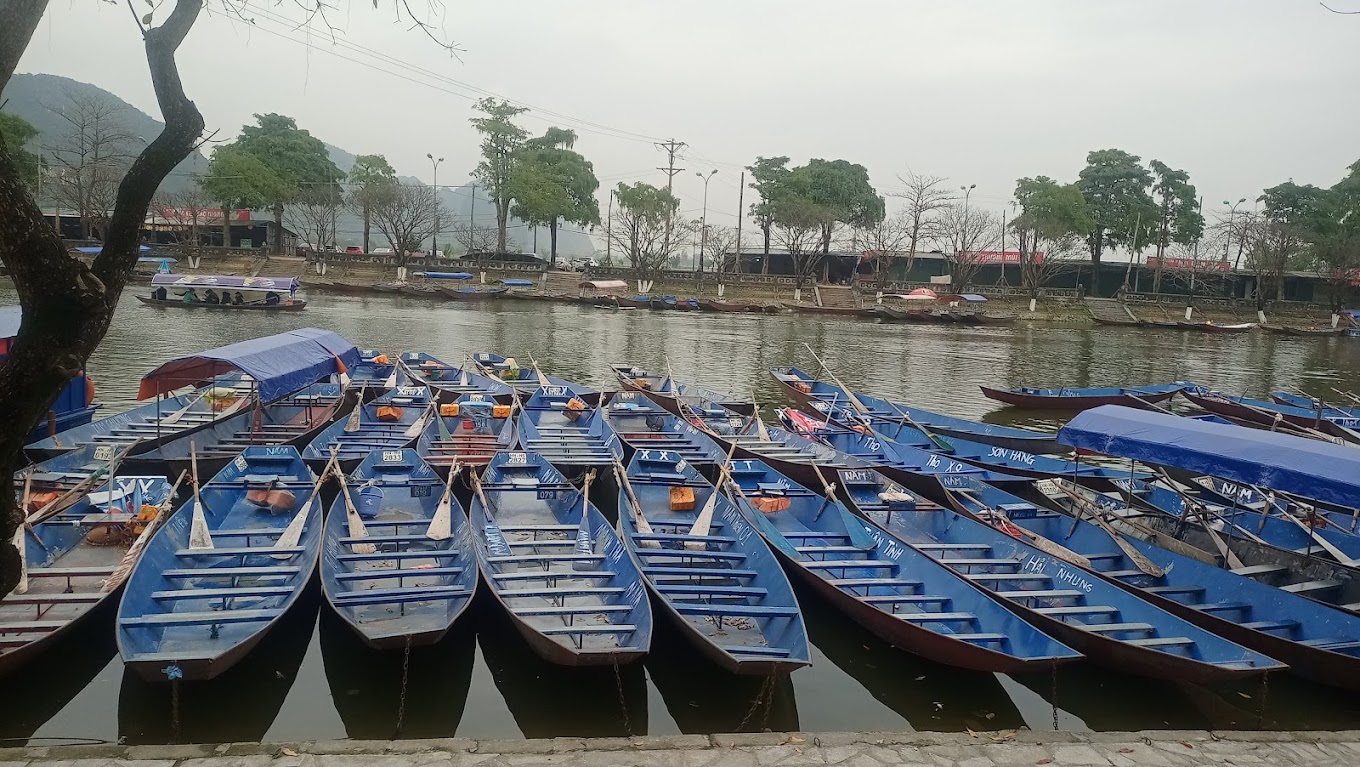
During festival season, Ben Duc is always bustling with tourists. Today, the boat dock has been modernized with small boats lined up, ready to serve visitors.
Yen Stream at Perfume Pagoda
One of the highlights of the journey to Perfume Pagoda is the boat ride along the tranquil Yen Stream. Immersing yourself in the beautiful natural scenery here, you will find peace before praying to Buddha.
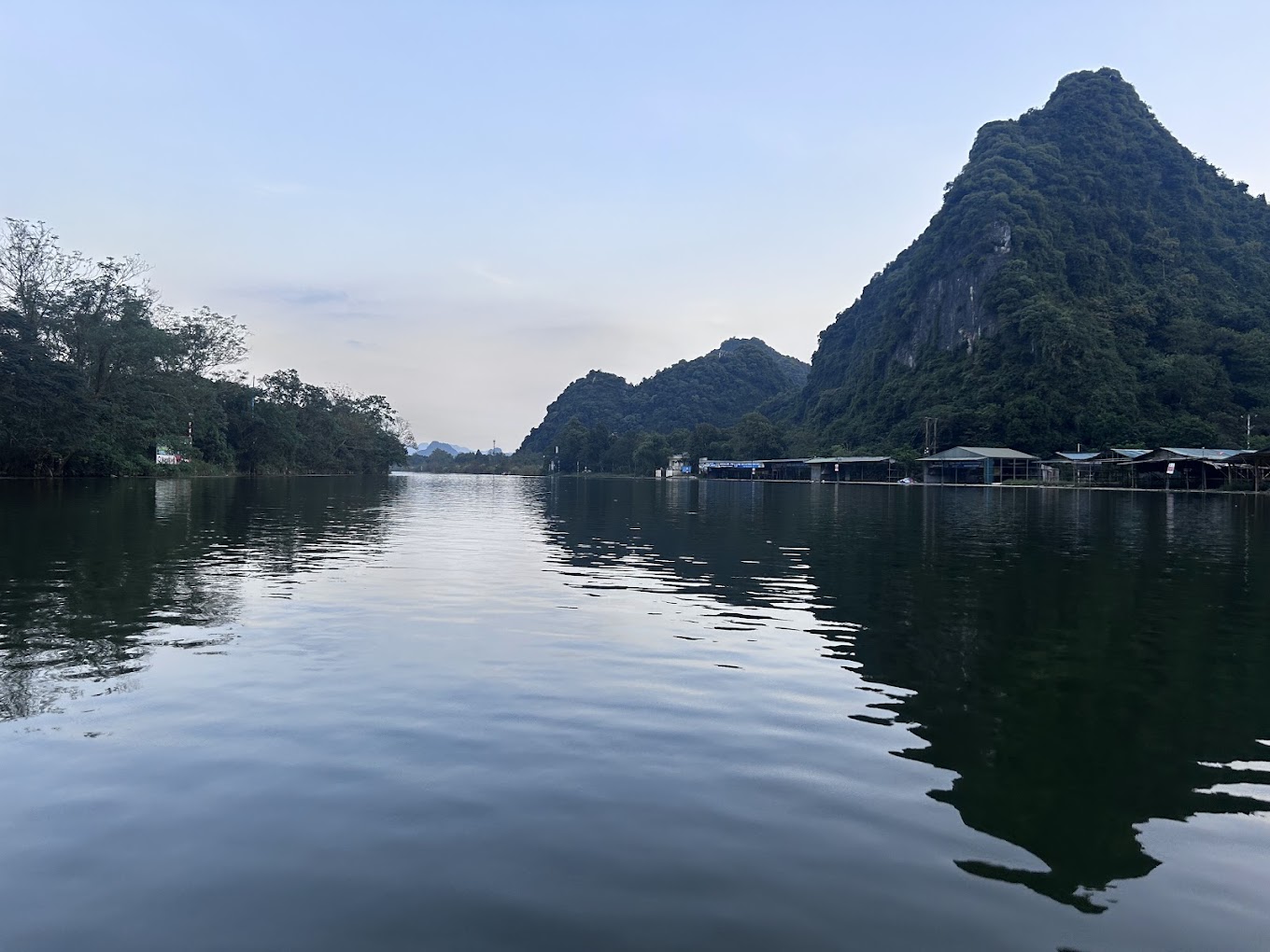
As you float along the Yen Stream, you can admire the lush green rice fields and the limestone mountains dotted with the vibrant red of bombax flowers. You’ll also have the chance to view the majestic Ngu Nhac Mountain, shaped like a dragon, and Trinh Temple, where pilgrims make their first stop on their journey to Perfume Pagoda.
Trinh Temple at Perfume Pagoda
This is the first stop after disembarking from the boat. Trinh Temple is a small temple located on the right side of the Yen Stream, about 500 meters from Ben Duc.
According to experience, this is the first place you should visit before exploring other historical sites. The name “Trinh Temple” signifies a place where people present and report their wishes to the supervising deities and local mountain and forest spirits. It is an important ritual to perform before entering Perfume Pagoda.
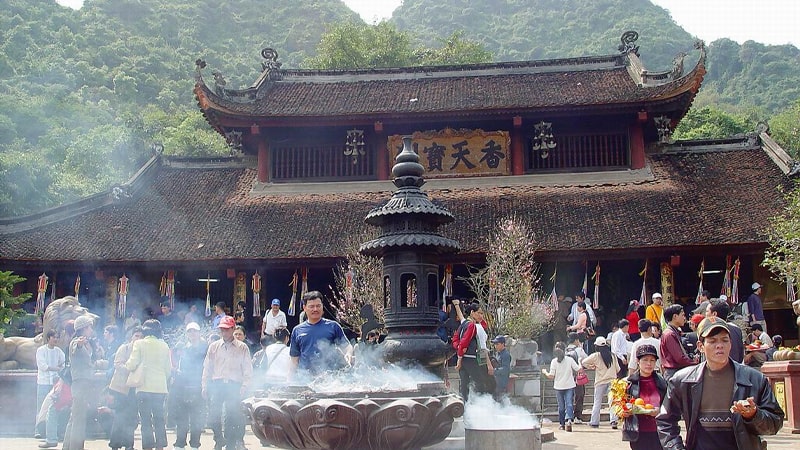
At Trinh Temple, you will offer your prayers and then continue by boat to other sites, including Huong Tich, Long Van, and Tuyet Son.
Long Van Cave
From Trinh Temple, a small stream called Long Van Stream stretches about 1.5 km. Visitors arrive at Long Van and from there, you will see a temple halfway up the mountain. A 150-meter climb is required to reach the temple.
From Long Van Temple, you can enjoy a panoramic view of the surrounding rice fields and mountains, with a winding river creating a serene and peaceful scene. Long Van Cave is not far away, just over the mountain pass. Inside the cave is a small Buddha shrine.
In addition to Long Van, the area also includes Hoa Than Cave and Cay Khe Temple, forming a beautiful scenic complex.
Thanh Son Pagoda
Located in the Thanh Huong area, this site includes Thanh Son Pagoda and Huong Dai Cave. Thanh Son Pagoda is an ancient pagoda hundreds of years old. From the entrance, you can see its moss-covered, ancient appearance with characteristic red tiles and intricately carved dragons.
In addition to worshiping Buddha and Bodhisattvas, the pagoda also honors Vietnamese Mother Goddesses and Saints, reflecting the rich religious and spiritual traditions of Vietnam.
Thien Tru Pagoda
Thien Tru Pagoda, also known as Ngoai Pagoda or Tro Pagoda, is near Ben Tro. Known as the “Most Unique Architecture of Nam Thien,” Thien Tru Pagoda is a cultural and artistic architectural work from the Le–Nguyen era. However, it was heavily damaged during the French colonial resistance. After peace was restored, the pagoda was rebuilt under the guidance of the late Venerable Thich Vien Thanh and Venerable Thich Minh Hien, becoming the center of the Huong Son landscape.
The old traces of Thien Tru Pagoda remain in the ancient stupa garden. Today, it has a large campus with many grand architectural structures, including Nam Thien Mon Gate, Quan Am Pavilion, and Chan Tinh Stupa. This is also a place where monks retreat for meditation.
Huong Tich Cave
The highlight of the Perfume Pagoda complex is Huong Tich Cave. After a long climb, pilgrims enter the cave, which feels like a paradise. Inside the cave is a green stone statue of Quan Am (Avalokitesvara) Bodhisattva, a sacred site for Buddhists and travelers.
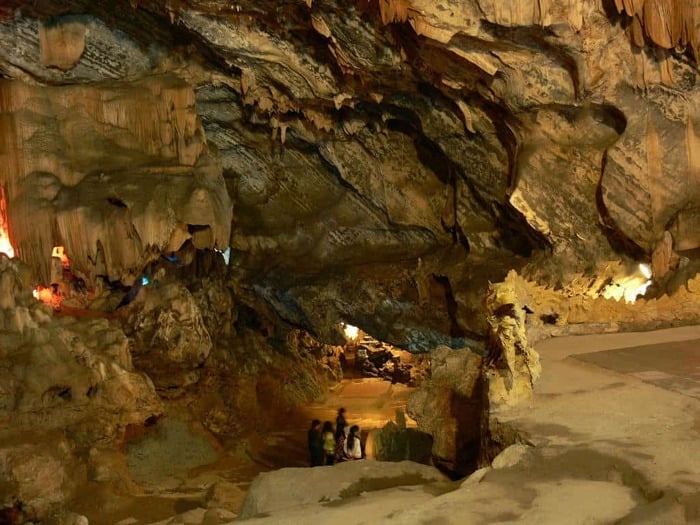
Huong Tich Cave is one of the most beautiful caves in the North, honored by Lord Trinh Sam, who called it “The First Cave of Nam Thien.” Inside the cave are large stalactites of various shapes. Near the entrance, a large stalactite called Dun Gao stands. The cave’s interior has a constant drip of water, believed to be “dragon’s milk” that brings tranquility and good fortune.
Giai Oan Pagoda
Giai Oan Pagoda lies to the left of the path from Thien Tru Pagoda to Huong Tich Cave. The pagoda is halfway up Long Tuyen Mountain and initially began as a small bamboo hut. Later, it was renovated with the inscription “Giai Oan Khe Tu” above its entrance.
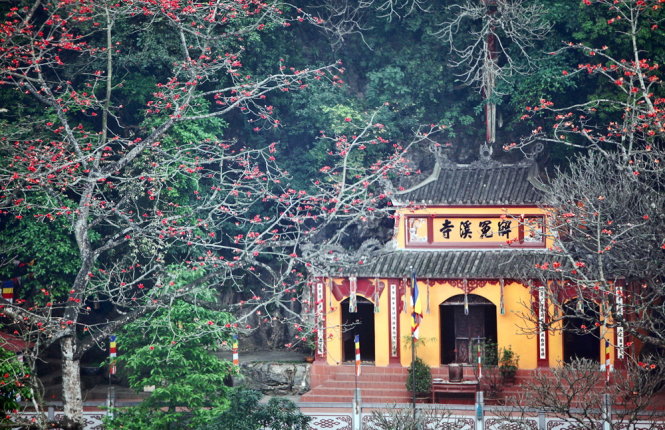
Giai Oan Pagoda features Thanh Tri Well, with clear water that never runs dry. According to legend, Quan Am bathed here to cleanse herself before entering the realm of Buddha.
Around the pagoda are Am Phat Tich, which houses a stone with the footprint of Quan Am, Tuyet Kinh Cave, dedicated to the Mountain God of Huong Son, and Tu Van Shrine, which preserves a four-armed Quan Am statue.
Cua Vong Temple
This temple has various names, such as Tran Song Temple and Van Song Temple. Originally, it was a small shrine built by locals to honor the forest princess, Le Mai Thanh Mau. Legend says this temple is where celestial maidens brought messages from the outer pagoda to the inner one.
Located on a high mountain, the temple offers beautiful views of the deep valley below. In 1800, Monk Hai Vien expanded the temple, making it a perfect stop before reaching Huong Tich Cave.
Bao Dai Pagoda
Bao Dai Pagoda, also known as Tuyet Son Pagoda, is reached by boat along Tuyet Son Stream. The 1.5-km journey from Phu Yen Village offers stunning views of majestic mountains and vast fields.
The pagoda follows the ancient architecture of the Le–Trinh era, though it has been renovated in the Nguyen dynasty style. The serene environment of Bao Dai Pagoda is further enhanced by a 300-year-old magnolia tree that shades the temple courtyard.
Tuyet Son Cave
From Bao Dai Pagoda, visitors follow a small path along the mountain for about 1.2 km to reach Tuyet Son Cave. The cave is halfway up the mountain and contains stunning stalactites compared to a dragon’s lair. At its entrance, three Chinese characters “Ngoc Long Dong” (Jade Dragon Cave) are carved, highlighting its beauty.
The cave has two sections:
- One is a Buddha shrine with a stalactite called “Cay Truong Tuyet” and a relief sculpture of Princess Ngoc Nuong.
- The other section is a shrine to the Mother Goddess, with stone statues of young boys and girls.
Things to Know When Visiting Perfume Pagoda
When attending the Perfume Pagoda festival, one important consideration is your attire. There are no strict rules regarding what to wear, but since this is a sacred place deeply rooted in tradition, it’s important to dress in a way that is both respectful and appropriate.
Here are some suggestions for what to wear when visiting Perfume Pagoda:
- Choose simple, neat, and comfortable clothing to allow for easy movement and participation in activities. Since you’ll be walking and hiking quite a bit, comfort is key.
- Opt for modest and simple attire in soft colors.
- Avoid wearing revealing outfits such as shorts, short skirts, tight clothing, or low-cut tops. Instead, choose more conservative clothing like traditional robes or an áo dài.
In addition, here are some tips for a smooth and enjoyable visit to Perfume Pagoda:
- Plan your trip in advance, including which areas of the pagoda you wish to visit and what you need to prepare.
- You can bring offerings for rituals, either from home or purchased at the pagoda, depending on whether you’re praying for peace, wealth, or family.
- Make sure to choose appropriate clothing for the visit.
- Check the weather forecast beforehand and pack essentials like a jacket, raincoat, or sun protection for your sightseeing.
- Bring along some snacks and drinks, as food and beverages in tourist areas can be expensive.
- Be mindful of keeping the area clean; avoid littering in the pagoda grounds.
- Since Perfume Pagoda can be crowded, especially during festival season, be vigilant with your personal belongings to avoid theft or pickpocketing.
- When shopping for souvenirs or local specialties, always ask for prices upfront and check expiration dates on any products you buy.
Special Dishes to Try When Traveling to Perfume Pagoda
When visiting Perfume Pagoda, besides enjoying the serene and sacred scenery, you also have the chance to try some delicious local specialties that reflect the flavors of the Huong Son region.
Yam (Củ mài)
Yam is a traditional food of the local people but has become an unmissable specialty for tourists visiting Huong Pagoda. Dishes made from yam, such as yam cakes, are known for their nutty, chewy, and fragrant taste.
Che Lam
Che Lam is a traditional sweet that’s familiar to the locals. Made from sticky rice, fresh ginger, and cinnamon powder, Che Lam has a light sweetness, a chewy texture, and is often enjoyed with hot tea, making it even more delightful.
Rau Sang
Rau Sang is a rare vegetable that visitors often seek out when they visit Huong Pagoda. This vegetable has a rich, sweet flavor and is typically cooked in soups with meat or fish. Due to its difficulty in cultivation, Rau Sang is quite expensive, especially during the festival season.
Perfume Pagoda Apricot (Mơ Chùa Hương)
Perfume Pagoda apricots are famous for their mildly sour taste, small seeds, and thick flesh. The festival season is also when the apricots ripen, and you’ll see many stalls selling Huong apricots. Visitors often buy them to make apricot wine or refreshing drinks, which are both delicious and healthy.
Enjoying these special dishes will not only give you a taste of the local cuisine but also create lasting memories during your visit to Perfume Pagoda.
Conclusion
The above information provides everything you need to know about traveling to Perfume Pagoda. Choose the right time to visit Perfume Pagoda based on your work schedule and preferences. If you have any questions regarding your trip to Perfume Pagoda, feel free to contact VnCarRentals.com for the best support. Don’t forget to check out the exciting travel experience articles on the VnCarRentals.com website! Wishing you a pleasant and safe visit to Perfume Pagoda!
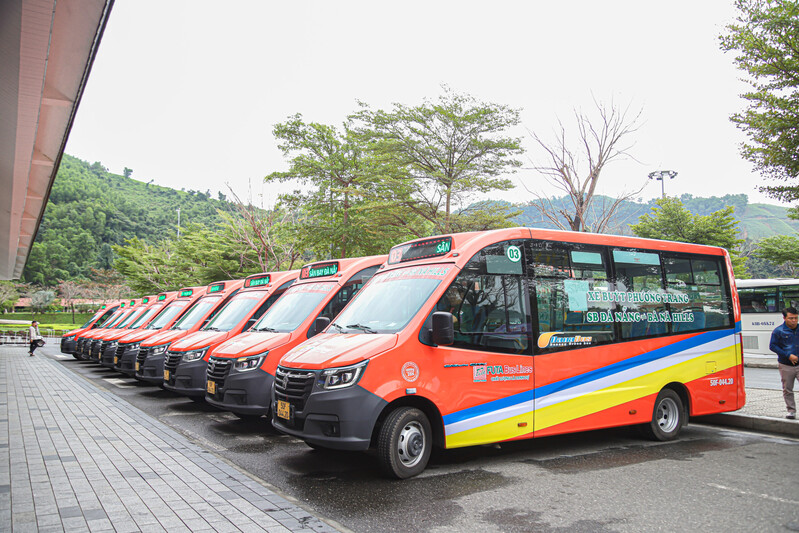
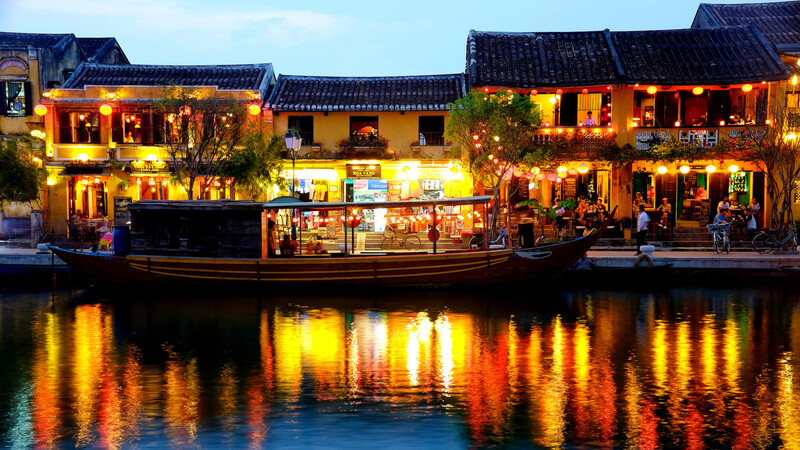
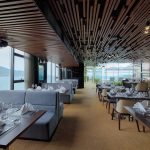
[…] The Perfume Pagoda is held at the scenic Perfume Pagoda complex, located in Huong Son Commune, My Duc District, Hanoi. […]